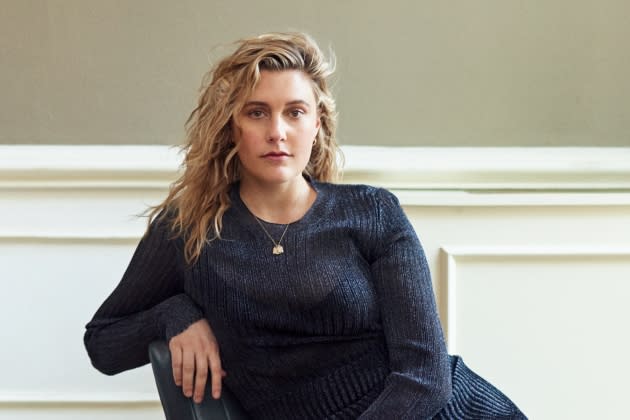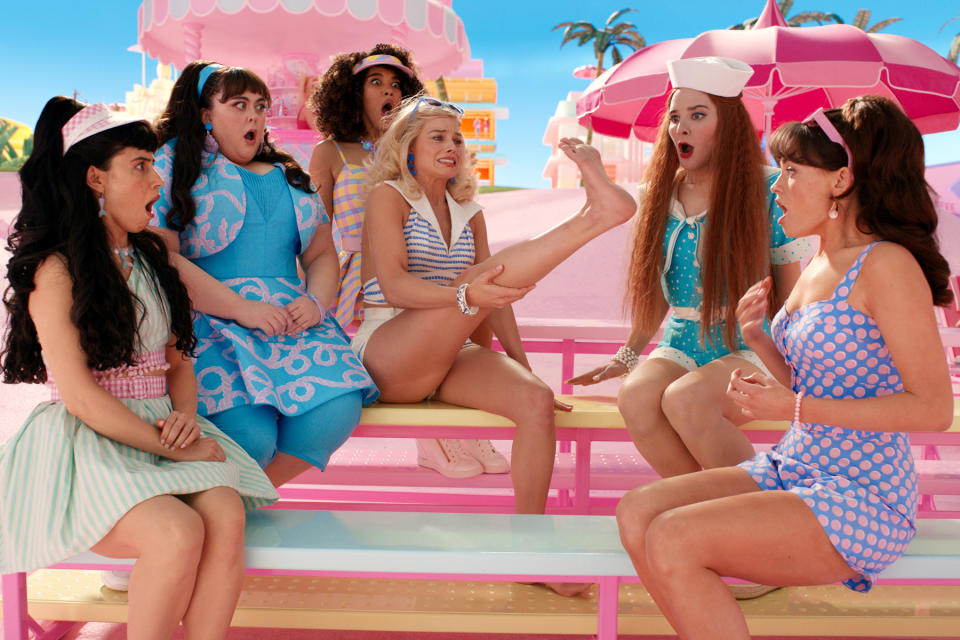‘Barbie’ Director Greta Gerwig on How She Got Ryan Gosling to Sing
- Oops!Something went wrong.Please try again later.

Barbenheimer wasn’t a thing yet when Greta Gerwig spoke to Rolling Stone about her Barbie movie back in early June, but she was already trying to will it into existence.
“I am such a huge Christopher Nolan fan,” she said. “My hope would be everybody goes to both. I guess we can guarantee that there will be incredibly different experiences. And I feel honored to be in the same sort of weekend company as Christopher Nolan.”
More from Rolling Stone
Here’s more from her in-depth interview — and if you haven’t seen Barbie yet, beware of spoilers. (You can also check out the first half of this interview here.)
Related
The Brain Behind ‘Barbie’: Inside the Brilliant Mind of Greta Gerwig
Greta Gerwig Crashes 'Barbie Premiere' at Alamo Drafthouse
‘Barbenheimer’ Asks: Who Ruin the World? Men.
How core to this whole project was the idea that Barbie would want to take a journey where she could become human?
I hope two things made that journey feel surprising but inevitable. I started from this idea of Barbieland, this place with no death, no aging, no decay, no pain, no shame. We know the story. We’ve heard this story. This is an old story. It’s in a lot of religious literature. What happens to that person? they have to leave, and they have to confront all the things that were shielded from them in this place. So that felt like one thing. And another thing felt like, well, it’s Barbie, who’s the queen of plastic! What better thing could we do then give her a real life? That would have to be the thing. Because it’s the antithesis of something that’s frozen. It’s ever-changing and decaying and becoming beautiful in its falling apart. And that’s the opposite of how we think of Barbie. So it felt like, of course, this has to be the journey. What other possible journey could we have done for this icon?
What was the thinking behind the very specific, very retro-Hollywood look of Barbieland?
It’s a movie world. It’s a soundstage world. It’s painted skies. It’s sculpted waves. “Authentically artificial” was the phrase that we came up with. The painted sky — that’s not the sky, but it’s real. It has tangibility. It’s right there. Barbie was invented in 1959, so we got to pick the best of everything in the Barbie iconography from 1959 to now, but at base, we kind of had this idea of a 1959 aesthetic. And I think that that sort of went along with what we wanted to do with the in-camera [effects] and the madness of it. We built all of Barbieland in miniature, and different scales of miniature. The goal was always that you would believe that we had 20 soundstages at all times. And everything needed to be decided, since we’re making this contained imaginary land. It was also like, “Is there water? No, OK, there’s not water. So what is it? It’s a giant sculpted Jeff Koons wave.” I was thinking about Heaven Can Wait, a wonderful movie that in some ways, on paper, shouldn’t work. And yet it does. You go with it. You believe everything, even though it’s high concept, and you care about it. And Grease, which is a movie about the 1950s. But it’s a disco musical! It takes place in high school, and they’re all 30! [Laughs] I loved it. The artifice is so sincere. And I think that that kind of thing just fit exactly what we wanted to do with Barbie.
What went into the great moment when Sasha, played by Ariana Greenblatt, reveals to Barbie how much some girls and women hate her?
When I was talking to Ariana about that scene, I was like, Sasha is smart, and she is incisive. And your certainty rests on the intellectual heft of what you’re saying. And I want you to be able to deliver that. And I think for me, what was so dramatically interesting about it was Barbie’s psychological state. Barbie doesn’t know anyone thinks this about her, right? Barbie wouldn’t wear the outfit she wore if she thought people didn’t like her! What better kind of a scene is there than to have two people walking into something with completely contradictory views of how this is about to go? And I also thought of being 13, and the moment when you are wanting to distance yourself from something you liked as a kid. And I’m gonna push it away with my newly-formed ideas of how the world is constructed.
America Ferrera is so great in this movie, with that amazing monologue. And centering her journey as a mother felt like such a surprising twist. How did that idea come to be?
America came at this from such a specific place. America’s so smart, and she’s so thoughtfu, as an actor and as an activist, as a writer, as a performer. She really has intellectual rigor with how she approaches things and also, she’s spectacular. As a parent you’re watching your child grow up, and you’re sort of remembering your own childhood as you’re there with them. There’s a lot of hall-of-mirrors quality to parenting. And because Barbie is a doll that’s been around since 1959, it’s a story that is always going to be generational. Barbie was created by Ruth Handler, based on watching her daughter play at a moment when baby dolls were the dolls available, and thinking to herself, “That’s not what she wants to do. She doesn’t want to pretend to be a mom. She wants to pretend to be an older girl, a grown woman.” And then, of course, her daughter was named Barbara and she named that doll Barbie. So to me, the mother-daughter story is baked into the essence of what Barbie is. So there was no other way for me to tell this story except as an intergenerational mother-daughter story — and centering the mother, really.

It somehow feels like your movies are infused with the same spirit as your performances as an actor. Does it feel like the same artistic energy for you?
I think actors, writers, directors, probably musicians, you’re always toggling in between control and planning and execution and rigor, and then what’s completely unexpected and messy and wild and from left field that you could never see coming. You’re always striking that balance, but usually people will fall more toward one than the other. And I think you have to be very alive to what your tendency is. Because I think especially as you get older, you can go to a place that feels comfortable to you more frequently. I think as an actor I had less accessibility to the discipline I have as a writer and as a director.
But as an actor, I did really like words, like that kind of battle between the two approaches. I like the sense of having all this very precise language, this set of rules and methodology. And then I have completely unexpected things I’m dealing with, and that’s the through line for me between all of them, is that the balance feels similar. It’s like someone said, every director is Kubrick in the morning and Cassavetes by the evening. Just got to get those shots done.
How did you settle on disco as a touchpoint for the Barbie soundtrack?
There was that great documentary about the Bee Gees directed by Frank Marshall, How Can You Mend a Broken Heart, that came out out during the pandemic while I was planning the movie. I remember watching that at a moment when I was sort of thinking about the psychological state of Barbie and how to explain it. In the documentary, they were talking about how disco was so huge and then there was this whole thing of “disco sucks.” And Barry Gibb saw it as a crushing realization that people think disco sucks. And the sort of positivity of disco felt very Barbie to me, because disco’s assumption about humans is that what they want to do when they get together is dance. What an optimistic idea of what humans want to do together! And it also related to the idea that Barbie is synthetic, and the idea of looped drums that had something synthetic, but it was handmade. It felt like all those things seemed connected to each other, the plasticity and the human emotion.
What did it take to get Ryan Gosling to sing “I’m Just Ken?”
He has a beautiful voice, and he’s a beautiful dancer. We kind of got there organically. I think if I had said, “I want you to sing and dance in this movie,” he would not have necessarily done that for me. But it was kind of that thing of boiling a lobster. I think by the time he was singing and dancing, he didn’t even totally know how we had gotten there. [Laughs] But he’s so fabulous at it. Mark Ronson talked a lot about glam-rock and Meat Loaf and the drama of that kind of song. And then Mark and his songwriting partner Andrew Wyatt wrote “I’m Just Ken.” They didn’t even have all the lyrics. They just had a feeling and the skeleton and the lyric “I’m just Ken,” and it just evolved from there. Because I was born in ’83 and going to movies in the Nineties, I wanted to create a moment that felt like those movies from the Nineties, when they had soundtracks to movies that ended up at Costco. [Laughs] I have this memory of looking at the track listing of all these movies at Costco.
(Read the first half of this interview here.)
Best of Rolling Stone

